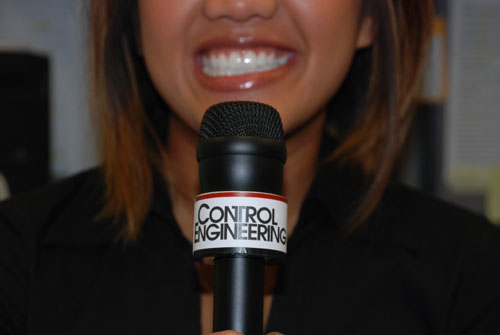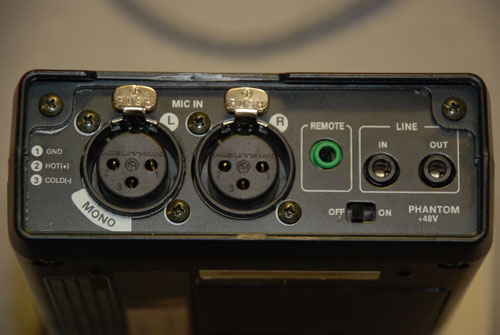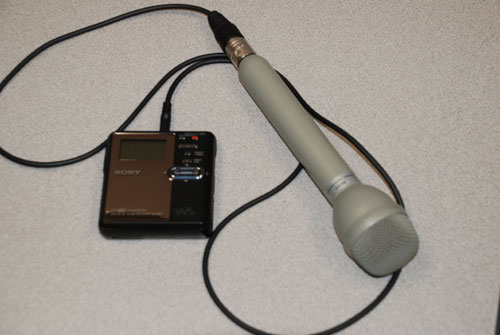Guest column by Peter Welander, Control Engineering process industries editor.
If you get involved in serious audio or video recording, you’ll soon find that you can spend a whole lot of money on microphones. What are these and what can they do for you?

Frances with RE50: Frances shows off the Control Engineering flag she made for our video productions. That microphone is a standard for hand-held interview applications.
If you buy a small digital recorder of camcorder, it will typically have a built-in microphone. These work, but they are designed in a way that does as good a job as possible in the broadest range of conditions. Since they are one-size-fits-all, they can’t be specialized. If your device has an external microphone input, it’s probably a stereo-mini, just like a headphone jack. You’ll find there aren’t many choices of things to plug into that jack, so those devices won’t be very specialized either.
Professional mics are made in every conceivable size, shape, purpose, and price. There are probably thousands of choices. They can be general purpose or amazingly specialized.

XLR mic connectors are very positive, lock in position, and are virtually indestructible, but they’re bulky. Note the quarter in the foreground for size.
One thing they have in common is a standard XLR connector. Most mics do not have a cord permanently attached. Instead they use a specialized three-pin connector that is virtually universal. Things that generate signals (outputs) use male connectors. Inputs use female connectors. This offers some very useful advantages:
- You can use the same mics and cables for all your applications.
- It uses a balanced line. I won’t try to explain it technically, but it means that you can have long wires without picking up hums and electrical noise.
- They are very durable. Good cables can be indestructible.
- They lock. Connections are difficult to pull out by accident.
But,
- They’re bulky and heavy.
- Good cables aren’t cheap.
- Cables that are cheap have crummy connectors.

Advanced recorders and video cameras have XLR inputs to take direct plug-in of cables.
Devices that have XLR inputs are serious. That is often one of the lines that separates amateur and professional equipment. The assumption is that the user wants the versatility and control that more specialized choices offer.

A simple patch cord allows you to use one or two pro mics with your mini recorder. This can make a big difference for your recording options.
What makes them different?
Microphones have different coverage patterns. Some are designed to pick up sound from any direction (omnidirectional) and others are more selective. One common selective design is cardioid, which favors sources more in front of it. This is better in a noisy environment, but you have to point it more carefully. Shotgun mics are extreme cardioid, and have a narrow pickup which makes them favorites for use on video cameras. (Wikipedia has a good discussion of this larger topic.)

Shotgun mics are favorites for shooting video since they concentrate their pickup on what the camera is pointed at, minimizing extraneous noise. Note the XLR inputs on the camera.
There are also different electronic mechanisms. The two most common are dynamic and condenser (aka, electret condenser). There are many differences between these, but for our purposes, there are only a few that we need to consider.
Dynamic:
- Very rugged.
- Do not need phantom power.
- Tend to be bulky.
- Not the strongest signal (input must be turned up more, possibly introducing more hiss).
Condenser:
- More delicate.
- Generally the first choice for the most critical applications.
- Need phantom power or internal battery.
- Can be very small or very bulky.
- Stronger signal (resulting in less hiss).
Most serious equipment provides phantom power so that’s not an issue, but the more delicate nature of condenser mics means that field ENG (electronic news gathering) designs are usually dynamic. Having stuff tossed in a bag is normal, so it can’t be fragile.
Use with any recorder?
You don’t have to have a professional recorder to use better mics. There are cords that provide a link from an XLR mic to the stereo-mini input on your small recorder or camcorder that sends the signal to both stereo channels. This allows you to get many of the mic’s benefits without buying more equipment. This may require some experimentation with your mic sensitivity settings, but can work very well. However, most small recorders cannot provide phantom power, so you’ll have to use a dynamic mic or a condenser with an internal battery.
This is a huge advantage when you’re trying to record someone standing and talking at an event. Trying to shoot video with a built-in mic in a noisy environment is a major problem.
I made a double adapter that allows me to use two mics, one on the left and one on the right channels. These are also available commercially.
Next week we’ll look at some specific mics so you can see what’s available. There are many features that you will find helpful in you know what to look for.
